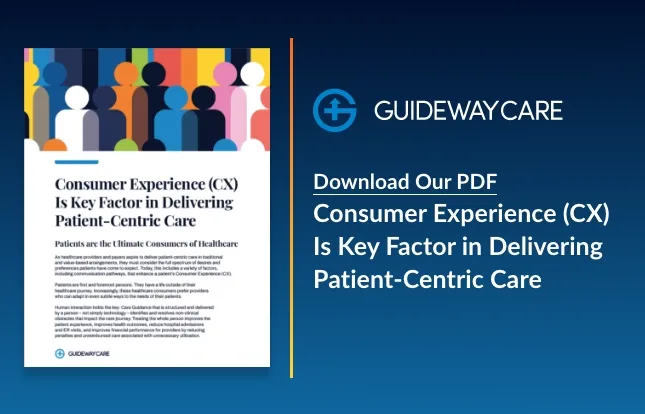HFMA: Care Guidance Offers a Solution for Addressing Healthcare Inequities

Key Points
- Social Determinants Impact Hospital Systems
- How Care Guidance Works
- The Value of the Human Touch
- A Solution to Mitigate Nursing Shortages
- Benefits Under Value-Based Payment Arrangements
- Key Considerations for Financial Leaders
Access to healthcare is widely viewed among Americans as being a fundamental right. Yet health inequities continue to deprive many people access to high-quality, affordable care. It is incumbent on U.S. health systems to take the lead in addressing this problem.
This is the critical challenge being addressed by Tina Graham, chief operating officer of Guideway Care, in her article now published by the Healthcare Financial Management Association (HFMA), a professional membership organization that helps healthcare finance management executives navigate the complexities of the healthcare industry.
Tina provides insight into the non-clinical drivers of patient inequities, namely social determinants of health (SDoH). She explains how care guidance programs partner with health systems as an extension of their clinical teams. As post-discharge care continuation support, care guidance contributes to achieving health equity objectives by reducing unnecessary utilization, lowering readmission rates, and improving patient experience and health outcomes.
To access this article in its entirety, click here.
How Social Determinants Impact Hospital Systems
An underlying driver of health inequities that perpetuate health disparities are social determinants of health (SDoH). These include five key domains: economics, education, healthcare, social context and environment.
Graham explains that SDoH typically fall outside the health system’s visibility and control. “It’s widely studied and reported that SDoH impacts a broad range of health, functioning and quality-of-life outcomes and risks. In fact, research shows that SDoH factors can drive as much as 80% of health outcomes.”
How Care Guidance Works and the Value of the Human Touch
To support an equitable path forward for all patients, health systems are finding value in strategically utilizing patient advocates and navigators whose scope is focused on activating patients to identify and promptly identify and resolve their disparities – before they become problematic and costly.
“Care guidance offers health systems a more direct way to serve patients on the margins of our healthcare system,” says Graham. “It adds a tech-enabled, human touch approach for reaching at-risk patients to uncover and resolve nonclinical issues that are impeding their ability to access and receive care.”
The success of a care guidance program rests largely upon the shoulders of specially selected and highly trained lay care guides who utilize tech-enabled platform and foster a deep and ongoing relationship with patients and their families. Serving as the main patient point of contact, a peer-to-patient connection is established that works to build trust, lowers a patient’s resistance to communication and uncovers potential issues they experience during their continuation of care.
Care Guidance Helps Mitigate Nursing Shortages
A key point of this article is how care guidance provides an innovative solution to the nation’s nurse shortages. Nurses are often tasked with addressing SDoH-related issues, including scheduling follow-up visits, ensuring transportation and attending to a myriad barriers to care attributed to SDoH. Care guides serve to free up critical time and capacity so that they can focus on clinical tasks and maximize efficiency.
Benefits Under Value-Based Payment Arrangements
Now more than ever, care guidance is becoming a “must have” addition to the service portfolio of hospitals and provider groups that are taking on shared risk with payers through value-based contracts. These providers are electing to participate in new arrangements that link payments to measured outcomes, health equity improvement, and overall quality performance indicators, such as hospital admissions, readmissions and closing gaps in care.
“The transition from traditional fee-for-service to value-based healthcare is rapidly accelerating as policymakers, regulators and payers align the efficacy of health equity initiatives with quality payment strategies,” adds Graham. “Care guidance is at the nexus of this change as an innovative approach to patient activation that is delivering ‘high-value, high-quality care’ to health plan members and Medicare beneficiaries and meeting incentivized provider goals in managed, value-based arrangements.”
Key Considerations for Financial Leaders
Although health system finance leaders tend to view investing in care coordination as a financial priority, few can measure and track their actual ROI from such investments. But to justify the investment, they must be able to measure activity, results and patient/caregiver response. When evaluating such an investment finance leaders should keep the following points in mind.
Care guidance provides a higher level of preventative patient care, in addition to ensuring treatment adherence, medication compliance and providing other support tasks within their scope. By directly and effectively addressing behavioral health equity, care guidance improves the provider’s ability to deliver patient-centered care and generate the best possible health and wellness outcomes.
Hospitals and their clinical staffs receive the extended support they need to deliver equitable care that optimizes patient experience, satisfaction and generates the best possible outcomes. This is where the proposition of care guidance presents the most value to all shareholders.
Guiding the Future of Equitable Healthcare
For more than 10 years Guideway has delivered a proven, scalable technology-enabled Service
as a Solution for advancing health equity in Value-Based Care. Partnering with hospitals/health
systems, payers and provider organizations, Guideway reduces health disparities, improves
patient/member satisfaction and lowers total cost of care.
Contact us for insight into how Guideway Care, as your partner, can implement an efficient and effective care guide solution to support your clinical team and deliver on the promise of health equity based on the needs of the patient populations in your community.
Contact Us Today To Learn How We Can Help
"*" indicates required fields




